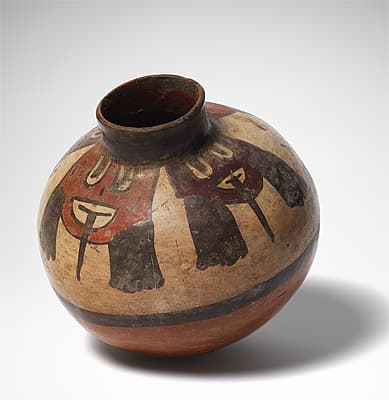
NAZCA culture South coast 100 – 700 AD
Vessel depicting trophy heads [Painted vase depicting trophy heads] c. 100–200 AD ceramic17.0 (h) cm 16.6 cm (diameter) National Gallery of Australia, Canberra NGA 1983.295 Purchased 1983
Vessels such as bottles, jars, urns and vases held an important place in ceremonial life. They contained chicha (corn beer), water or grain and were buried as grave goods. Representations of severed heads on ceramics show the Nazca becoming an increasingly warlike culture. Captured enemies were ritually decapitated and their heads offered to the gods. Trophy heads can be identified by their large or closed eyes, protruding tongues and bunched hair.
Vessels such as bottles, jars, urns and vases held an important place in ceremonial life. They contained chicha (corn beer), water or grain and were buried as grave goods. Representations of severed heads on ceramics show the Nazca becoming an increasingly warlike culture. Captured enemies were ritually decapitated and their heads offered to the gods. Trophy heads can be identified by their large or closed eyes, protruding tongues and bunched hair.
Vessels such as bottles, jars, urns and vases held an important place in ceremonial life. They contained chicha (corn beer), water or grain and were buried as grave goods. Representations of severed heads on ceramics show the Nazca becoming an increasingly warlike culture. Captured enemies were ritually decapitated and their heads offered to the gods. Trophy heads can be identified by their large or closed eyes, protruding tongues and bunched hair.

